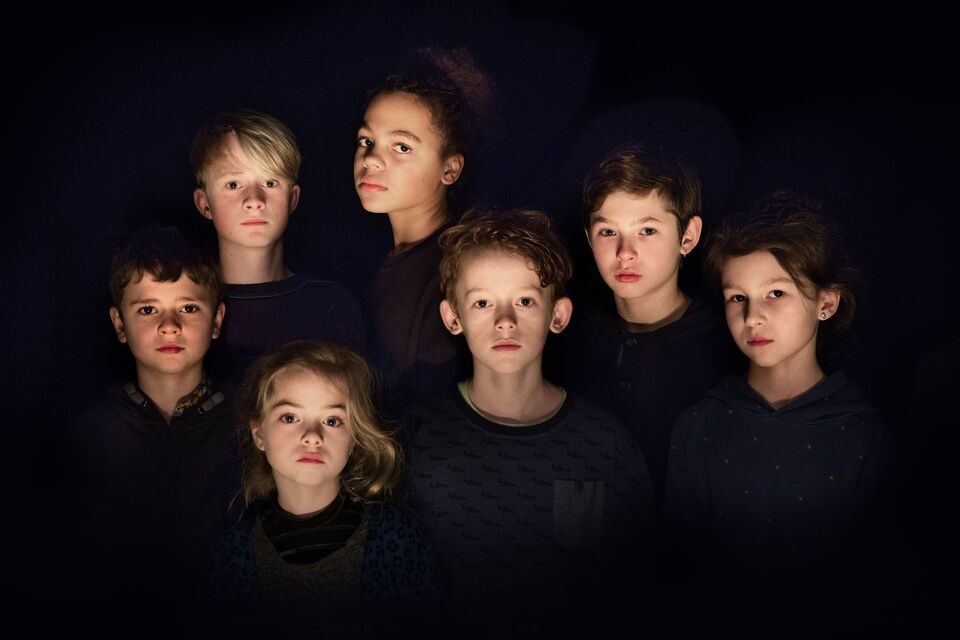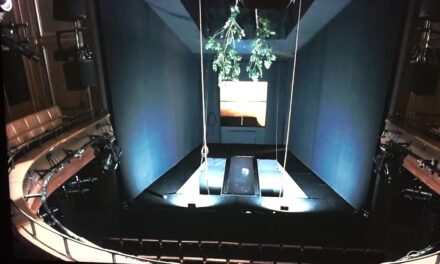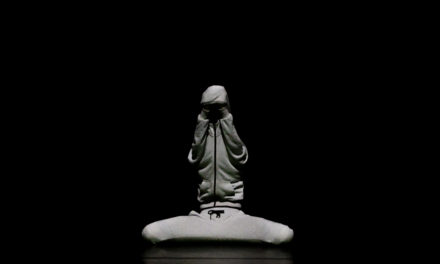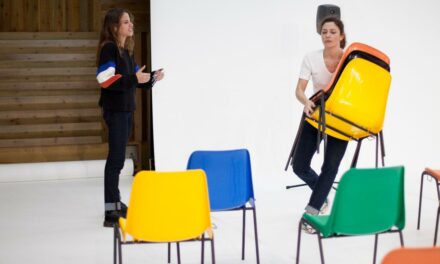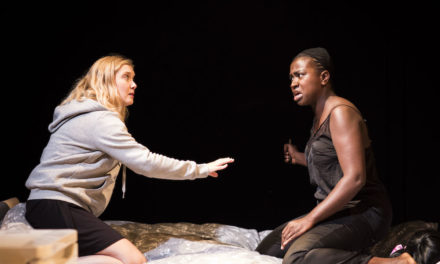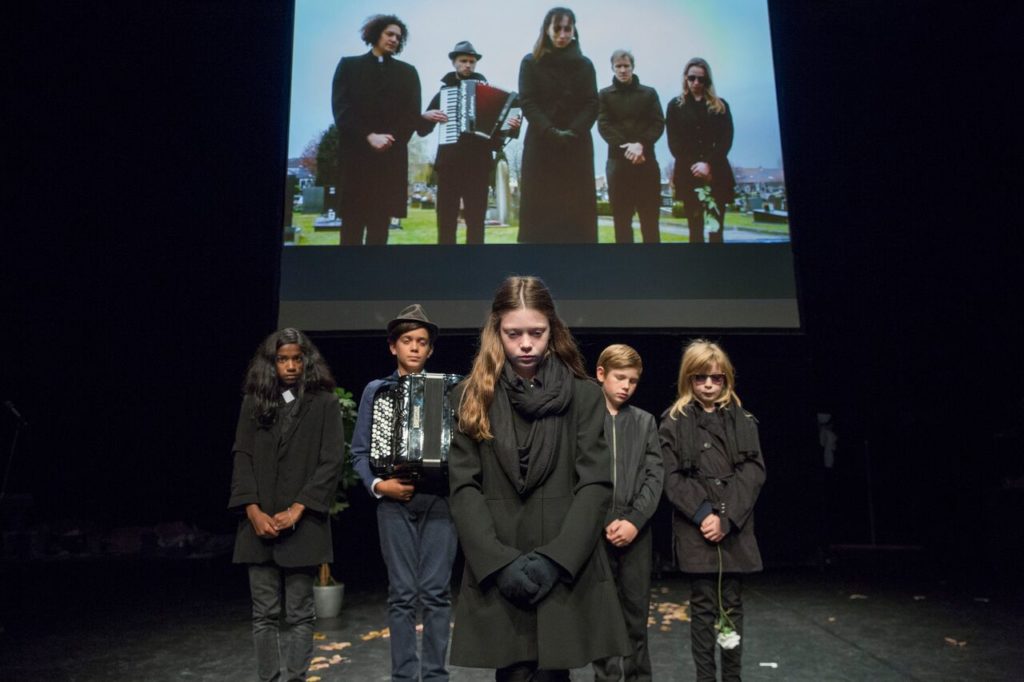
Photo credit: Phile Deprez
It’s not often that a children’s theatre features a piece about a pedophile and child murderer in its repertoire. But on rare occasions when vision, intelligence, and courage align, this kind of programming can change lives.
Last week, Swiss director Milo Rau’s piece made by the commission for Ghent’s Campo theatre and dealing with the Belgian child murderer Marc Dutroux was shown at London’s Unicorn theatre for two nights. No less than nine institutions from Europe and Singapore are listed as co-producers of this extraordinary theatrical experiment which has already been on tour for a couple of years. Although it is performed by a cast of seven pre-pubescent children and one adult, this piece is not primarily aimed at a young audience, and it is not easy viewing for adults either–especially not the parents of young children. As a matter of fact, there is nothing easy about it at all.
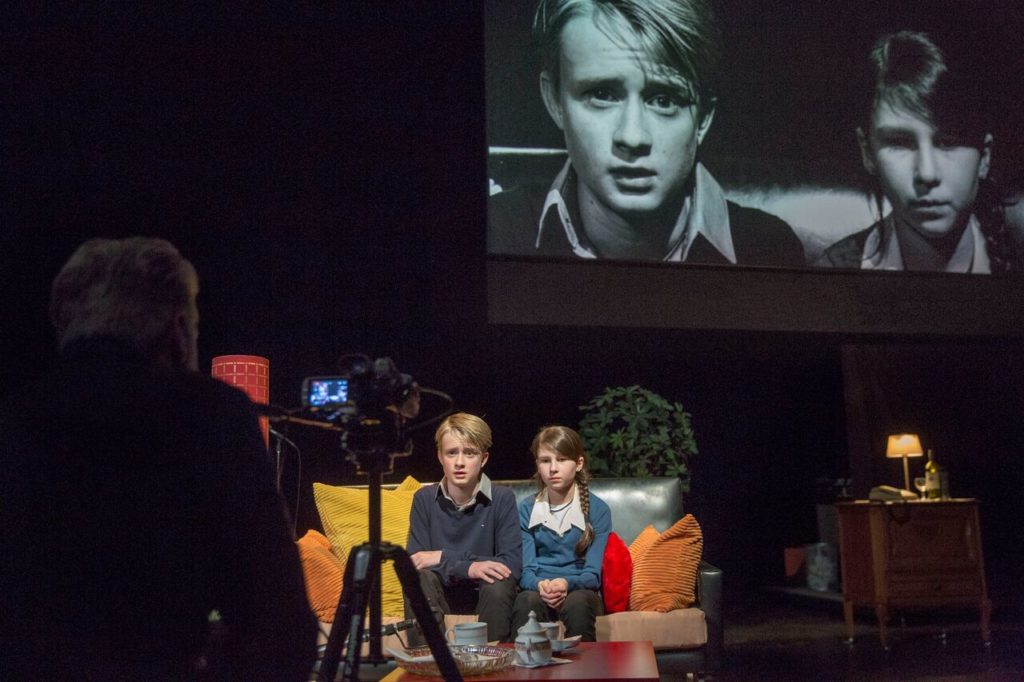
Photo credit: Phile Deprez
The Dutroux case has been weighing on the Belgian national psyche for more than two decades. Though the young cast here doesn’t have living memories of the events, the parents of the six victims are still grieving and, as it happens, Dutroux’s own father is still living with the difficult legacy of the case too. Rau’s sociological approach to making theatre entails an all-encompassing inquiry, so the first of the five scenes forming part of this probing 90 minutes, interestingly focuses on Dutroux senior and his own memories. The stories span decades and continents, charting the days of the Belgian empire–another difficult topic for Campo’s original audience. The old man is played by a ten-year-old boy, wearing just enough makeup to add a layer of make believe but not too much to suggest a caricature. He speaks to a camera and we can simultaneously watch the way in which the scene is constructed on stage and the way in which it is mediated on screen. The gap creates a space for reflection, and this is basically an encapsulation of the method of the piece as a whole.
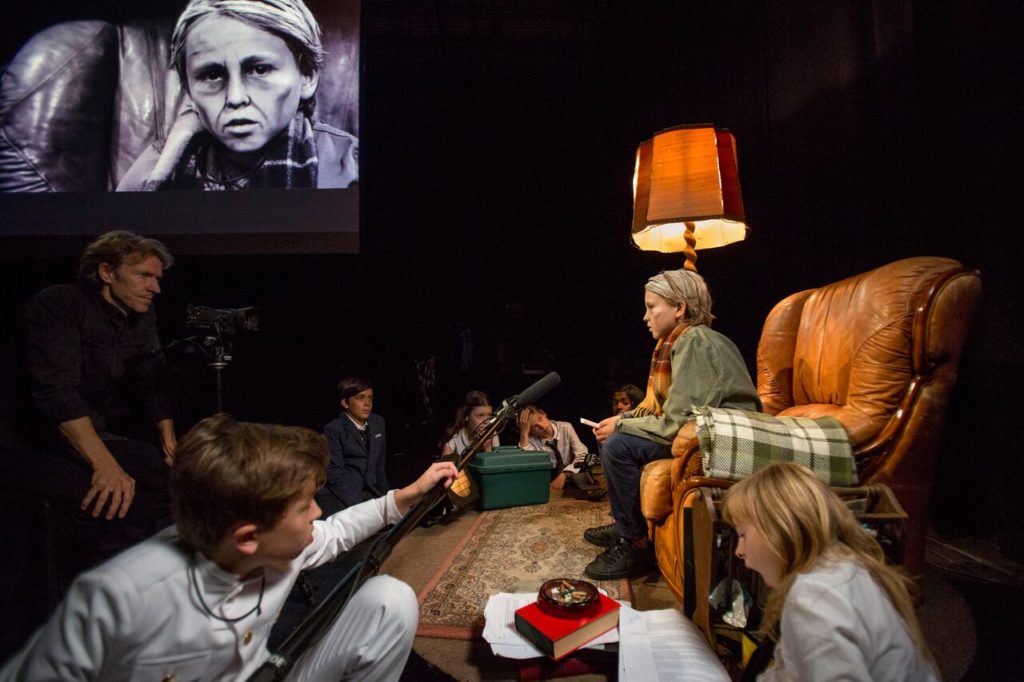
Photo credit: Phile Deprez
There is an outer framing to the five scenes giving us an opportunity to meet the child performers and find out about their interests, biographies, and their own thoughts about life and death. They are gently coached through this process by adult actor Peter Seynaeve, who has also worked as Rau’s assistant on the piece. This initial overture takes the form of a casting session, therefore, led by Seynaeve. A happy balance of humor and philosophy makes up this outer frame, leading us safely into the more uncomfortable territory of sheer torment and suffering. Later scenes, for example, feature a close up on a semi-naked eight-year-old girl, speaking the “letters to her family” from the dark depths of captivity, followed by a blow by blow account of a father’s story of loss. The procedure is carried out with a clinical, almost surgical, precision–and as the case might be within a medical context, there is no space for sentimentality in it. In a post-show discussion afterward, we find out that the work was largely motivated by a desire to address and deal with the key national traumas of Belgium’s recent past as a means of achieving healing and moving on. And a child psychologist was involved in this process too.
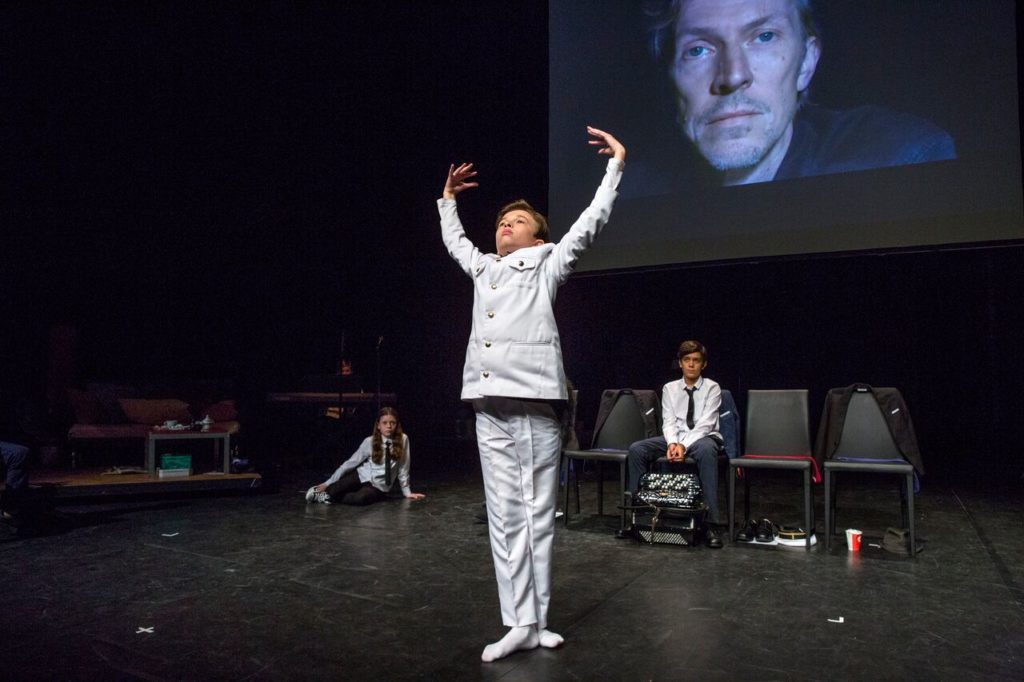
Photo credit: Phile Deprez
Despite the many ethical questions that an undertaking such as this one might raise in a theatre context–why is an outsider digging through the painful history of a nation, how can the use of children be justified in this context–the main redeeming feature of the work is contained precisely in its cold scientific method. A convention deployed throughout, and further justifying the use of video technology on stage, is that many of the chosen protagonists in the piece are represented by adult actors in pre-recorded scenes on the screen before they are played by the children on stage. This method which can be seen to follow in the tradition of theatrical re-enactment has a pragmatic didactic purpose too–evoked by the title itself borrowed originally from Stravinsky, but also, in turn, from Abramović and others who have quoted or paraphrased it before. Acknowledging their natural lack of emotional experience, the child actors are prompted to use and practice the basic skills of mimicry as a means of learning how to be adults, both for the needs of the stage and as a means of their own personal process of growth. Other skills covered by these theatrical drills include studies of power, subjection, imagination, etc. The piece also sees itself as following in the footsteps of Tim Etchell’s and Gob Squad’s previous work with children. At an age of trigger warnings, when the Western society’s overriding tendency is to wrap our children in cotton wool, this is ultimately a truly heroic objective on a number of levels.
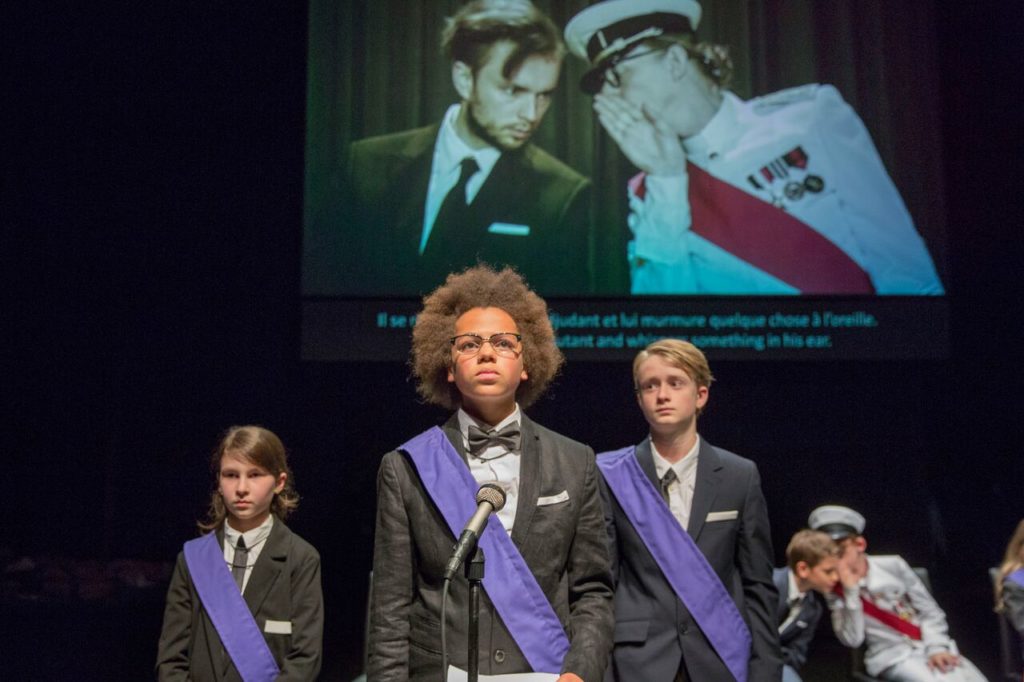
Photo credit: Phile Deprez
London’s Unicorn theatre was founded in 1947. Throughout its history, it has combined a children’s repertoire by day with an adult repertoire by night as a means of financial survival. In 2005 it moved from West End’s Arts Theatre to its new award-winning home in London Bridge. For the last six years, under the leadership of Purni Morell, it has been characterized by bold and adventurous programming which treats children with respect and bestows them with civic responsibility. The jewels of British and European theatre such as Ignace Cornelissen, Ellen McDougal, Tim Crouch, Ontroerend Goed, Marius von Mayerburg have all had the platform to inspire and engage local audiences aged 0 and above. I have rarely seen a children’s theatre fill up with excited audiences of all ages– and at the same time incidentally rubbing shoulders together with the who’s who of London theatre–as often as I have witnessed this at the Unicorn in recent years. The same was the case on the night of Five Easy Pieces, though not without a certain sense of impending loss as Morell passes the baton on to her successor Justin Audibert as the new Artistic Director of the theatre. Audibert is bound to continue to rock, if his recent track record is anything to go by, but it is hard not to read the timing of Morell’s decision in sync with the changing climate in the pre-Brexit Britain. How long before this sort of programming becomes consigned to history?
Concept, text, direction: Milo Rau
Dramaturgy: Stefan Blaske
Direction assistant and performance coach: Peter Seynaeve
Set and Costume design: Anton Lukas
Co-produced by: Kunstenfestivaldesarts Brussels, Munich Kammerspiele, La Batie – Festival de Geneva, Kaserne Basel, Gessnerallee Zurich, Singapore International Festival of Arts, SICK! Festival UK, Sophiensaele Berlin, Le Phoenix scene nationale Valenciennes pole europeen de creation
Performers: Rachel Dedain, Bruna Frederick, Maurice Leerman, Pepijn Loobuyck, Willem Loobuyck, Polly Person, Peter Seynaeve, Winne Vanacker, Sara De Bosschere, Pieter-Jan de Wyngaert, Johan Leyser, Jan Steen, Ans Van den Ende, Hendrik Van Dorn, Annabelle Van Nieuwenhuyse
This post was written by the author in their personal capacity.The opinions expressed in this article are the author’s own and do not reflect the view of The Theatre Times, their staff or collaborators.
This post was written by Duška Radosavljević.
The views expressed here belong to the author and do not necessarily reflect our views and opinions.

